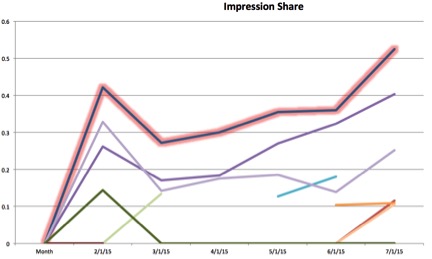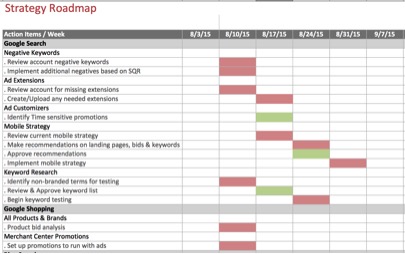As PPC marketers, we often have to-do lists that run a mile long and take up most of our day. This, of course, is a good thing because it means that we are getting tasks done within the account that should improve day-to-day performance. However, we are sometimes so focused on the tactical that we forget to look at the bigger picture and create strategic plans toward account growth and performance.
Even though there’s no shortage of completed tasks within the account, we must not ignore developing strategy, as it can guide us down the road and highlight which tasks are actually the most important to accomplish within an account.
How To Think Strategically
While many PPC account managers have the tactical nailed down, we sometimes need help with the strategic. Below, I will outline some steps to take to start getting your mind focused on the strategic elements of account management.
1) Understand the goals of the account. This is always the first place I start when thinking about account strategy because the goals dictate the plan I’m going to develop. Is your goal to increase lead volume? Increase traffic? Make an effort to truly understand where this account needs to go, so that you can implement a strategy that makes sense. If you work on the agency side of things, great questions to ask the client are:
- What are the main goals of the account?
- What have you tried in the past to achieve this goal that’s been successful or unsuccessful?
2) Learn about the company. If you’re doing in-house PPC, you might be able to skip this step, as you are probably immersed in the company all day, every day. However, if you’re on the agency side and have just been assigned a new client, do yourself a favor and take the time to understand what the company does and how their business functions. If they are ecommerce, take the time to look at their products and understand their sales goals. For a moment, pretend that you are their in-house PPC manager and learn about the company from all angles.
3) Look at the competition. In many cases, taking a peek at the company’s competition can help you devise a good strategy. Using Google’s Auction Insights, you can get a clear picture of who is competing with you for impression share and position. Take a close look at what those companies are doing and decide if there are any takeaways for you.

4) Make a plan. Now that you understand the company and its goals, as well as the competition, it’s time for you to devise a plan on how you’re going to reach your goals. This is where the strategic thinking comes in. For example, if we know that one of the main goals in the account is to increase sales, we might want to then devise a strategy that is focused around increasing conversion rate. Included in that strategy might be tactics such as:
- Allocating more budget to converting keywords
- Implementing a CRO program
- Adding geo bid modifiers
- Reviewing negatives
5) Understand that plans can change. Many times, you’ll see that you set a PPC strategy in place, only to learn that business plans have changed, thus making your strategy less relevant. Learn to be flexible in your planning and adjust strategies as the company changes their goals. While this might not always be easy, it does ensure that your eyes are always on the company’s goals.
6) Put it on paper. Once you’ve developed your strategy, there will likely be many tasks that need to be accomplished. While this may seem overwhelming at first, putting it all on paper in an organized plan will make it go much smoother. Create a roadmap that you can share with your colleagues and clients that details a true path to reaching the goals you have set. This roadmap should be your strategy in action, highlighting all of the tactics that you are going to use to reach your end goal. It should include timeframes in which these tasks are going to be accomplished as well.

7) Review the roadmap. Once your roadmap is created, devote time to discussing it with others and get their feedback on both the tactics and the timing. While something may make perfect sense to you, it might not to another. Use this roadmap as a springboard for deeper discussion and make sure that everyone is on the same page with regard to goals, strategies and tactics. If they aren’t, this is the time to discuss changes and revise the roadmap.
8) Gather resources. While it’s actually exciting to develop a roadmap that addresses strategic thinking, it’s important to ask yourself if you have all of the resources necessary to actually accomplish everything you need to do within the desired time frame. If not, you may need to pull in additional resources and farm out certain tasks. However, if you don’t have access to those resources, this is the time to have an honest conversation with yourself and revise those deadlines to something more realistic. This is also a great time to make sure that the tasks on your roadmap are properly prioritized and rearrange if necessary.
9) Set your plan in action. Now that you’ve put a great deal of thought into the strategy of the account, set that roadmap in action. As you go through the process, you may find that changes need to be made. Don’t be afraid to do that if needed. PPC is fluid and sometimes dictates changes that we can’t foresee.
10) Gauge results. Once you’re deep into completing items on your roadmap, stop and take a look at the progress you’ve made with regard to account goals. Is the account any closer to reaching its goals today than it was before you started this process? Are the tactics you noted bringing you closer to achieving your PPC goals? If so, then your roadmap is leading you down the right path. If not, then now is the time to understand why it’s not working and revise accordingly.
Final Thoughts
While it may not always be easy to think strategically when it comes to PPC account management, it’s something that all PPC account managers should be doing. If we don’t understand the goals and strategy, it will be hard to understand which levers need to be pulled within the account and can hinder success. At the forefront of any account management, take the time to follow the ten steps above and you’ll be on the road to success.



